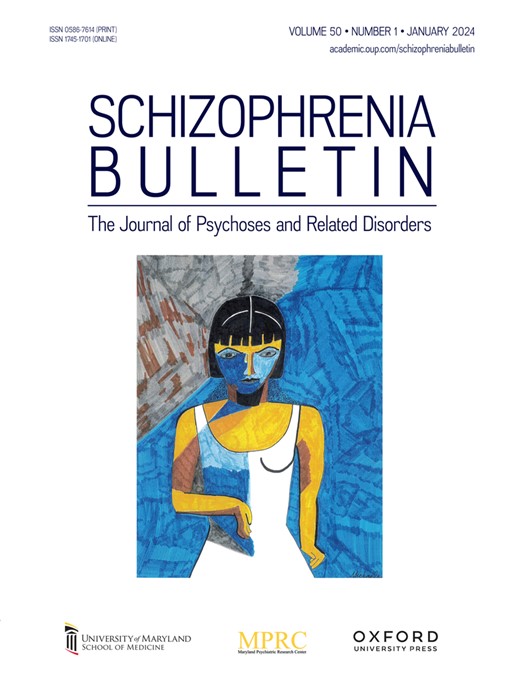More Severe Brain Network Hierarchy Disorganization in Treatment-Naive Deficit Compared to Non-deficit Schizophrenia and Underlying Neurotransmitter Associations
IF 5.3
1区 医学
Q1 PSYCHIATRY
引用次数: 0
Abstract
Background and Hypothesis Deficit schizophrenia (DS) represents a distinct entity characterized by primary and enduring negative symptoms, yet the neurobiological differences between DS and non-DS (NDS) remain undetermined. Using a gradient-based approach, we hypothesize that DS and NDS will exhibit convergent and divergent brain functional hierarchy patterns, each with a specific underlying neurotransmitter architecture. Study Design Resting-state functional magnetic resonance imaging images were acquired from 44 treatment-naive DS, 55 treatment-naive NDS, and 60 matched healthy controls (HCs). Gradient metrics were calculated using the BrainSpace toolbox. The spatial correlation between gradient abnormalities in DS or NDS and density maps of 10 neurotransmitters derived by the JuSpace toolbox was analyzed to link the neuroimaging to underlying neurotransmitter information. Study Results Both DS and NDS exhibited compressed gradient patterns compared to HC, suggesting reduced network differentiation, with more severe disorganization in DS. The ventral attention network was associated with depression symptoms in DS, whereas the visual network was related to total, general, and paranoid symptom scores in NDS. Moreover, spatial correlation of neurotransmitter analysis revealed that the gradient alterations of DS were primarily related to the serotonergic system while those of NDS were predominantly associated with the dopamine system. Conclusions The study suggests that independent from the potential effects of antipsychotic medication, DS and NDS are characterized by different neuropathology in brain hierarchy patterns, potentially linked to neurochemical metabolic distinction. Our findings support the hypothesis that DS is a distinct subtype versus NDS from neurodevelopmental perspective.与非缺陷精神分裂症相比,治疗初始缺陷更严重的脑网络层次紊乱和潜在的神经递质关联
背景与假设缺乏性精神分裂症(DS)是一种独特的个体,其特征是原发性和持续性的阴性症状,但缺乏性精神分裂症与非缺乏性精神分裂症(NDS)之间的神经生物学差异尚未确定。使用基于梯度的方法,我们假设DS和NDS将表现出收敛和发散的脑功能层次模式,每个都有特定的潜在神经递质结构。研究设计静息状态功能磁共振成像图像来自44名未接受治疗的DS, 55名未接受治疗的NDS和60名匹配的健康对照(hc)。使用BrainSpace工具箱计算梯度指标。分析DS或NDS梯度异常与JuSpace工具箱导出的10种神经递质密度图之间的空间相关性,将神经成像与基础神经递质信息联系起来。研究结果与HC相比,DS和NDS均表现出压缩的梯度模式,表明网络分化程度较低,DS的无序性更严重。腹侧注意网络与退行性痴呆的抑郁症状相关,而视觉网络与退行性痴呆的总、一般和偏执症状得分相关。神经递质空间相关性分析表明,DS的梯度变化主要与血清素系统有关,而NDS的梯度变化主要与多巴胺系统有关。结论除抗精神病药物的潜在影响外,DS和NDS在脑层次模式中具有不同的神经病理特征,可能与神经化学代谢差异有关。我们的研究结果从神经发育的角度支持了DS与NDS是不同亚型的假设。
本文章由计算机程序翻译,如有差异,请以英文原文为准。
求助全文
约1分钟内获得全文
求助全文
来源期刊

Schizophrenia Bulletin
医学-精神病学
CiteScore
11.40
自引率
6.10%
发文量
163
审稿时长
4-8 weeks
期刊介绍:
Schizophrenia Bulletin seeks to review recent developments and empirically based hypotheses regarding the etiology and treatment of schizophrenia. We view the field as broad and deep, and will publish new knowledge ranging from the molecular basis to social and cultural factors. We will give new emphasis to translational reports which simultaneously highlight basic neurobiological mechanisms and clinical manifestations. Some of the Bulletin content is invited as special features or manuscripts organized as a theme by special guest editors. Most pages of the Bulletin are devoted to unsolicited manuscripts of high quality that report original data or where we can provide a special venue for a major study or workshop report. Supplement issues are sometimes provided for manuscripts reporting from a recent conference.
 求助内容:
求助内容: 应助结果提醒方式:
应助结果提醒方式:


